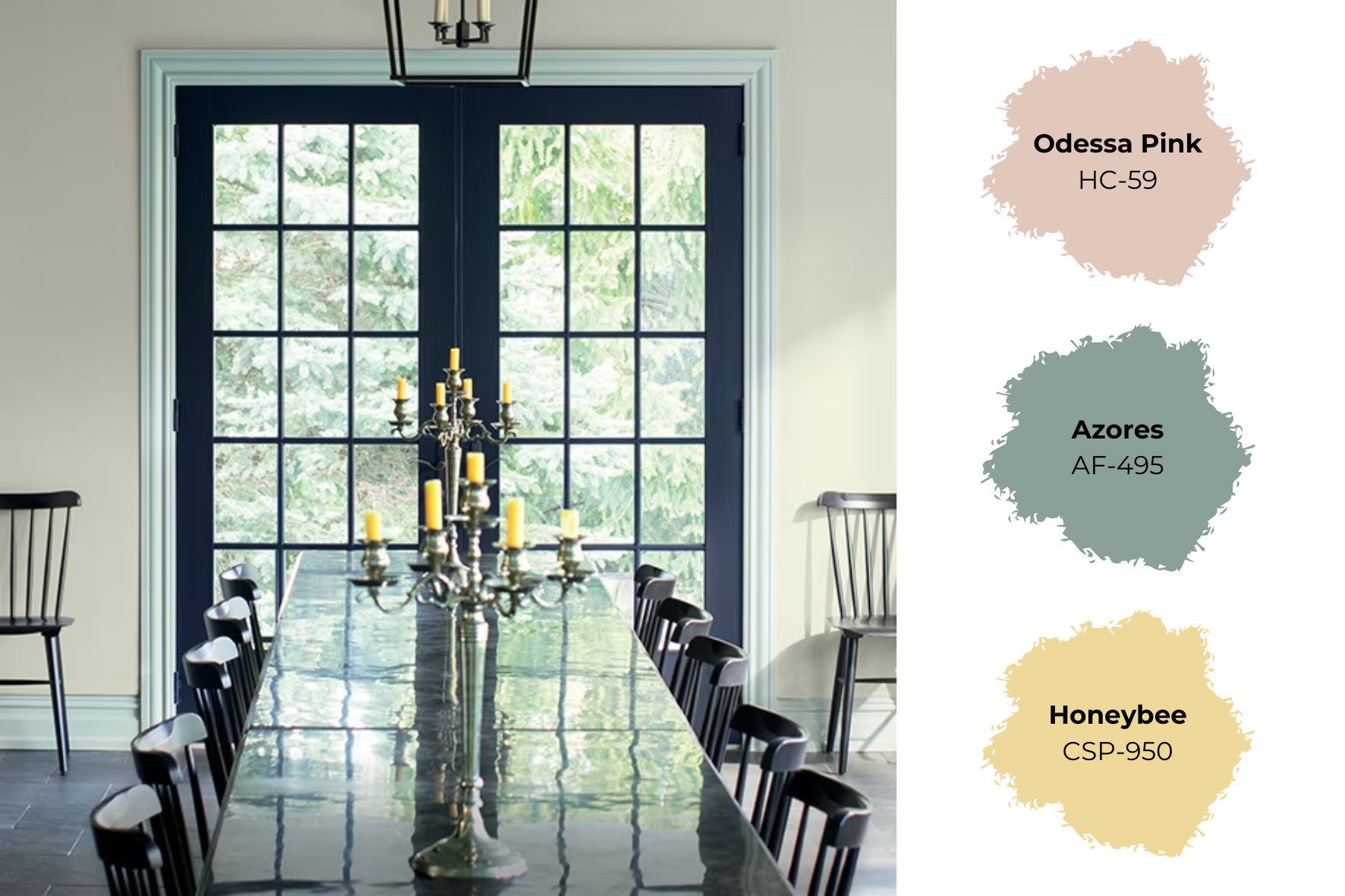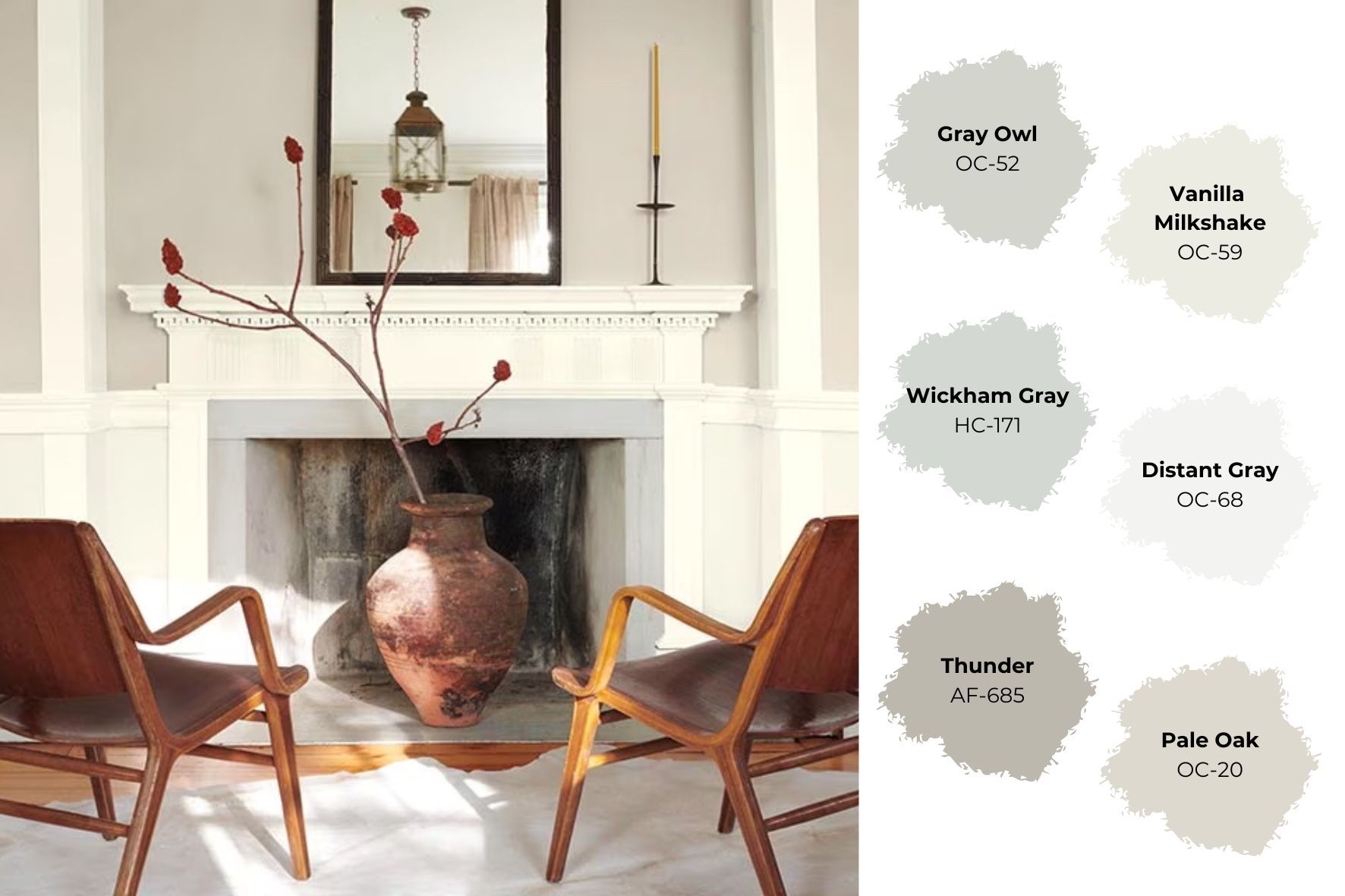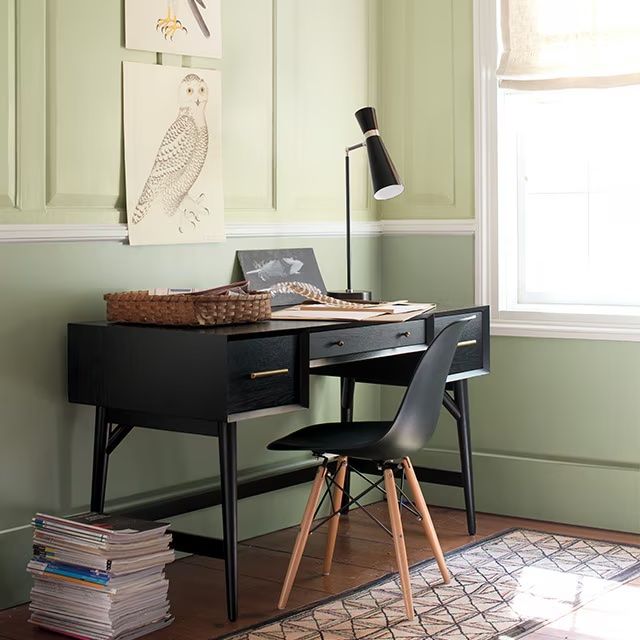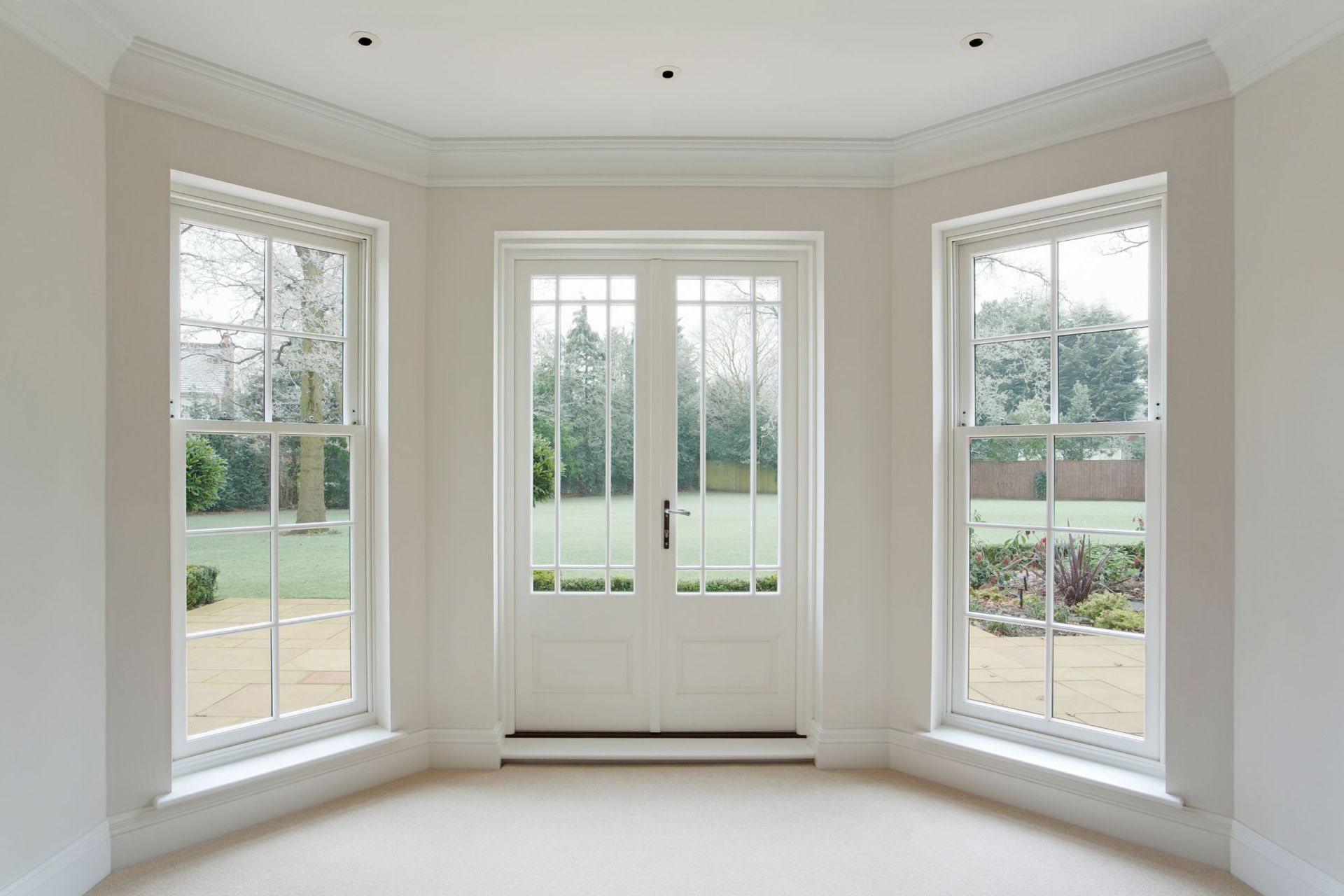Interior trim is often an overlooked aspect of home design, but when chosen and applied thoughtfully, it can completely transform a room. From crisp, classic shades of white to bold, saturated hues that make architectural features pop, interior trim colors can either serve as the star of the show or act as the perfect supporting player.
No matter your style, trim offers an opportunity to make a statement in subtle or striking ways.
In this guide, we’ll explore how you can harness the design power of Benjamin Moore interior trim paint colors. Whether you’re leaning toward a timeless, neutral trim or experimenting with daring shades, we’ve got the tips, inspiration, and tricks to help you make the right choice for your space.
What Types of Trim Molding Are There?
Before you start painting, it’s important to know the various types of trim you might be working with. Each type has a distinct role in shaping the look and feel of your room. Here’s a rundown of the most common types of trim:
Baseboards/Floor Trim: These are the trim pieces that sit at the bottom of your walls, providing a clean line between the wall and floor. Baseboards can be simple or intricate, depending on the room’s style.
Crown Molding/Ceiling Trim: Installed at the top of your walls, crown molding adds elegance and sophistication to a room, framing the ceiling in a formal and refined manner.
Window Mullion: While not technically trim, mullions are the vertical or horizontal divisions between windowpanes. They’re often painted in contrasting colors like white or black to emphasize the window’s architectural details.
Window Casings/Window Trim and Door Casings/Door Trim: These trim pieces surround windows and doors, providing a finished, polished look around the openings in your walls.
Wall Trim: Applied directly to the wall, this trim serves a decorative purpose. Examples include chair rails, wainscoting, and picture frame molding, all of which can add texture and interest to a space.
Now that we’ve outlined the different types of trim, let’s dive into color options to make each feature stand out (or blend in) beautifully.
What Are the Most Popular Trim Paint Colors?
When it comes to choosing trim paint colors, bright, crisp white remains a classic favorite. White trim provides a clean, beautiful frame in any space. Whether paired with neutral walls for a serene look or bold walls for contrast, white trim has long been a go-to for homeowners.
However, white isn’t your only option. If you want your trim to stand out or complement your walls in a more adventurous way, consider going beyond the basics. Bold colors, subtle neutrals, or even black can create stunning visual effects.
In this dining room example below, two distinct paint colors highlight the beautiful French doors: Hale Navy HC-154 on the door’s mullions and Smoke 2122-40 on the trim.
Here are a few colorful trim paint options to spark your creativity:
Odessa Pink HC-59 Azores AF-495 Honeybee CSP-950

Dining Room Image – Benjamin Moore
What Paint Finish Should I Use on Trim?
The paint finish you choose for your trim is just as important as the color. The finish not only affects the look of the trim but also its durability and ease of maintenance.
For trim, satin, semi-gloss, or high-gloss finishes are the most popular choices. These finishes provide durability, resist stains, and can withstand repeated washing, which is essential for trim in high-traffic areas like hallways, kitchens, and bathrooms. The sheen creates a smooth, polished surface that adds dimension and contrast to the space, especially when paired with matte or eggshell wall finishes.
If you’re unsure which finish is best for your trim, stop by your local paint store and ask for expert advice.
Ideas for Trim Paint Color
Now that you understand the basics of trim paint, let’s explore some creative ideas for using color to enhance your space. Whether you’re going for a timeless white or a bold hue, these trim paint ideas will inspire you to take your interior design to the next level.
1. Go-To White Trim Paint
White trim never goes out of style, but finding the right shade of white can be tricky. Look at the undertones of your wall color to determine the best white for your trim. For example, if your walls have warm undertones, you’ll want a white with similar warmth. Cooler walls pair well with crisp, clean whites.
Versatile white trim colors to consider include:
Steam AF-15 Super White OC-152 Chantilly Lace OC-65
2. All-White Trim: A Classic Look
All-white trim can be bold when applied thoughtfully. To achieve a fresh, modern look, use the same white paint for your walls, ceiling, and trim but vary the sheen to add depth and highlight architectural details. This technique works particularly well in rooms with high ceilings or intricate molding.
3. A Take on White Trim and Gray Walls
Gray walls paired with white trim is a timeless and elegant combination. To create a cohesive look, make sure the undertones of the gray and white are complementary.
Here are a few gray and white combinations to try:
Gray Owl OC-52 with Vanilla Milkshake OC-59 Wickham Gray HC-171 with Distant Gray OC-68 Thunder AF-685 with Pale Oak OC-20

Fireplace Image – Benjamin Moore
4. White Trim and Bold Walls
White trim can also make a vibrant wall color pop, creating a dramatic contrast that highlights intricate molding and millwork.
Try these bold wall and white trim combinations from Benjamin Moore:
Rosepine 461 with Cloud Cover OC-25 Sea Life 2118-40 with Pale Oak OC-20 Modern Romance CSP-435 with Pristine OC-75
5. White Trim Paint for Bathrooms
Crisp white trim provides a clean frame for richly colored bathroom walls. Let your walls and décor take center stage while white trim and wainscoting play a subtle, supporting role.
Pair Baby’s Breath OC-62 trim with Stormy Sky 1616 walls for a soothing, spa-like bathroom.
6. Gray Trim, White Walls
For a modern twist, reverse the typical color scheme by pairing gray trim with white walls. This unexpected combination adds depth and dimension to any room, and it works especially well in minimalist or contemporary spaces.
Try these gray trim colors:
Temptation 1609 Steel Wool 2121-20 Stormy Monday 2112-50
7. Trim in a Monochromatic Color Scheme
If you want to make a smaller room feel larger, try a monochromatic color scheme where the trim is painted in a different shade of the same color as the walls. This technique blurs the edges of the room, creating a seamless, expansive look.
For a monochromatic scheme, try:
Blue: Walls in November Skies 2128-50 , accents in Evening Dove 2128-30 , and trim in Lily White 2128-70 Purple: Walls in Blue Viola 1424 , accents in French Violet 1427 , and trim in Violet Sparkle 1422 Green: Walls in Sagebrush CSP-770 , accents in Secret Path CSP-800 , and trim in Halo OC-46

Image – Monochromatic color scheme by Benjamin Mooore
8. Breezy Blue Trim Colors
Blue trim is perfect for spaces with ample natural light. Stick to soft pastel shades for an airy, light feel, or go for a deeper hue for a coastal or traditional vibe.
Some favorite blues for trim include:
Blue Hydrangea 2062-60 Breath of Fresh Air 806 Amsterdam AF-550
9. Make a Statement with Bold Green Trim
Bold green trim brings a fresh, dynamic energy to any room, creating a connection to nature and adding a vibrant pop of color. From deep forest greens to jewel-toned emeralds, green trim can be a striking design choice that adds personality and sophistication to your space. It works exceptionally well with neutral walls, offering a stunning contrast that highlights architectural features like windows, doors, and baseboards.
For a classic green trim, try:
Regent Green 2136-20 Bavarian Forest 2054-10 Gothic Green 637
10. Elevate Your Space with Bold Black Trim
Black or dark gray trim adds instant drama and sophistication to any room, providing a striking contrast that defines architectural features and elevates your space. Paired with white or neutral walls, black trim creates a high-impact, timeless look reminiscent of classic French design. It adds depth and sharpness to a room, making door frames, windows, and baseboards stand out in a bold, elegant way.
For an extra touch of style, incorporate black accents like patterned rugs, furniture, or artwork to complement the trim and create a cohesive, chic atmosphere.
Try these black and white pairings:
Frostine AF-5 with Black Satin 2131-10 White Dove OC-17 with Witching Hour 2120-30 Paper Doll CSP-485 with French Beret 1610
11. Create a Natural Vibe with Soft Green Trim
Soft green trim brings an earthy, calming touch to any room, making it an ideal choice for those looking to introduce nature-inspired tones into their interiors. Muted greens, like sage or olive, add warmth and serenity without overpowering the space, creating a subtle contrast that complements both neutral and richly colored walls. This gentle hue works beautifully in living rooms, entryways, and kitchens, where you want to evoke a peaceful, organic feel.
Pair soft green trim with warm whites or soft grays for a cohesive, tranquil design.
Benjamin Moore favorite green-gray trim colors include:
Gray Mirage 2142-50 Cheyenne Green 1502 Elemental AF-400
Your trim plays a significant role in defining the style and atmosphere of your home. Whether you choose classic white, bold black, or vibrant color, thoughtfully painted trim can elevate your space from ordinary to extraordinary. Consider your room’s architecture, color palette, and natural light when selecting the perfect trim color, and don’t be afraid to experiment with something new.
With these Benjamin Moore trim paint color ideas, you’re sure to find the perfect shade to highlight your home’s best features!

